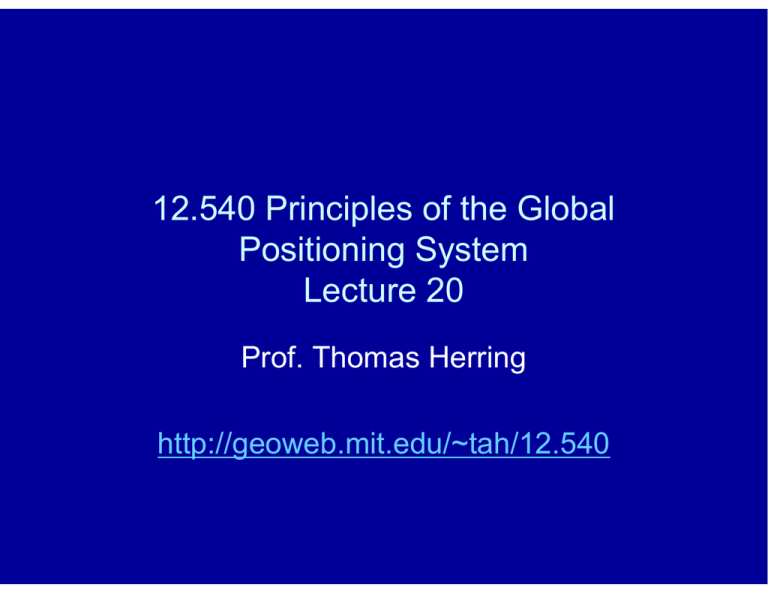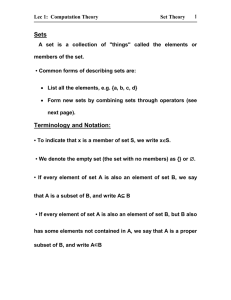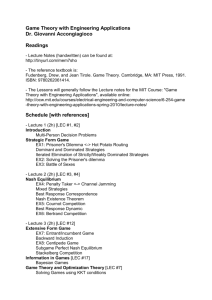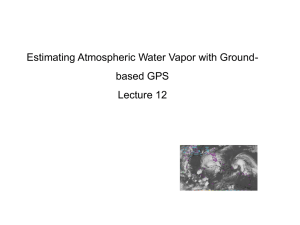Document 13567194
advertisement

12.540 Principles of the Global Positioning System Lecture 20 Prof. Thomas Herring http://geoweb.mit.edu/~tah/12.540 Processing Software • Examine basic features of processing software and methods – Files needed – General overview of the MIT GAMIT/GLOBK suite of programs 5/02/2012 12.540 Lec 20 2 Primary research programs • Geophysical research GPS analysis packages: – GAMIT (GPS at MIT): Uses double differences – GYPSY: Jet Propulsion Laboratory (JPL) processing packages: Uses one-way observables and explicitly estimates clocks – Bernese: Developed at Astronomical Institute University of Bern, Switzerland. Also referred to as BPE (Bernese Processing Engine). Double differences. 5/02/2012 12.540 Lec 20 3 Files needed for precise geodesy • For all programs the basic class of files needed to accurately compute the apriori models of the delays and phase: – Table of satellite types. Since the PRN numbers are re-used (1-32), there could be ambiguity about the mass, size and phase center position of the satellites. There is a unique SV number for each satellite. Latest is 54. – Ephemeredes of Sun and Moon. Needed for tidal forces on satellite. Can be in tabular form (most common; HarvardSmithsonian Center for Astrophysics and JPL produce these) or in analytic form (accuracy problems). Ephemeredes can also be used for Earth tide calculations. 5/02/2012 12.540 Lec 20 4 Files needed – Nutation tables: Give position of Earth’s body axis in space. Needed for transforming orbits integrated in inertial space back to Earth fixed frame or to compute the coriolis forces if integrated in Earth fixed frame (not common). – Leap second table. Allows conversion from GPS time to UTC. Offset included in broadcast ephemeris so not strictly needed if broadcast ephemeris used. Leap seconds are announced by the IERS – Polar motion/UT1 tables. Needed in the transformation from inertial to earth fixed frame. Available through the IERS. If earth-fixed orbits used not strictly necessary. – Ocean tide loading model tables. Either in the form of station dependent values or in a grid that is interpolated. Recent addition. Signals are diurnal and semidiurnal mainly but alias through 24-hour averaged site positions more effectively than would be expected. 5/02/2012 12.540 Lec 20 5 Files needed – Antenna phase center model tables. Give the deviations of the phase as a function of elevation angle (and possibly azimuth) relative to a fixed point on the antenna (the ARP-antenna reference point). If the same type of antenna used in a small area, then not strictly needed but with mixed antenna types or large extent networks (such that satellites are seen at different elevation angles) then needed. May also need a file that translates names of antennas in RINEX files into standard names (IGS maintains list of standard names for antennas). 5/02/2012 12.540 Lec 20 6 Files needed – Station information that gives position of ARP relative to ground mark. Strictly this should be in RINEX file header but is often incorrect. Getting this information correct is often the biggest problem in campaign GPS processing. Information is recorded on paper log sheets that need to be transcribed correctly. Often referred to as meta-data for RINEX file. – Apriori coordinates and velocities for sites (can extract position from RINEX header but these are often not very good) – Apriori orbit information for satellites. If working near real-time than maybe use “yesterdays” orbit extrapolated forward. – Atmospheric and water loading. Not normally used or available although some groups use a local pressure admittance model (need to be careful when comparing results). 5/02/2012 12.540 Lec 20 7 Specific programs • The files before are generic that all programs need. Specific programs use other files to control them. • We will examine GAMIT which the MIT developed GPS program. There are two basic modules: GAMIT and GLOBK 5/02/2012 12.540 Lec 20 8 Basic framework: GAMIT • GAMIT: Series of programs that process GPS phase data • Parameters estimated: – Station positions – Satellite orbits parameters • Initial conditions • Radiation parameters • Phase center offsets – Earth orientation parameters (EOP) – Atmospheric delay parameters • Time dependent Zenith delays and gradients – Carrier phase ambiguities 5/02/2012 12.540 Lec 20 9 Basic framework: GLOBK • GLOBK: Uses parameter estimates and full covariance matrices from different sources to combine results • Inputs from GPS, SLR, VLBI and SINEX files • Used to estimate quantities such as: – Site velocities from series of measurements – Satellite orbit improvement – EOP parameters – Other derived parameters 5/02/2012 12.540 Lec 20 10 GAMIT Structure • • • • History Data types Steps needed in processing Files needed for processing 5/02/2012 12.540 Lec 20 11 GAMIT History • Development started in late 1970s when MIT was building GPS receivers • Code derived from 1960-1970 Planetary ephemeris and VLBI software • Ported to Unix in 1987 • Start of IGS in 1992 prompted development of automatic processing schemes • Fully automatic processing mid-1990s including continuous stations and campaign GPS measurements 5/02/2012 12.540 Lec 20 12 Current GAMIT Status • Automation features: – FTP'ing of data and other files – Extraction of information from RINEX files – Automatic directory creation – Status/Warning files generated to monitor process • Largest automatic run: Southern California Earthquake Center Campaign Data set from 1992-2002. 5/02/2012 12.540 Lec 20 13 Data Types • L1 and L2 phase used for parameter estimation • P1 and P2 range measurements: – Cleaning data – Receiver clock error estimates (tolerance 1 microsecond=300m) • L1 and L2 combined to form ionospheric-free observable LC • Ionospheric delay called LG • Melbourne-Wibena Widelane WL 5/02/2012 12.540 Lec 20 14 Processing steps - Major • GPS satellite orbit integration (arc) • Modeling phase and partial derivative generation (model) • GPS data cleaning and cycle slip repair (autcln) • Least-squares estimator (solve) 5/02/2012 12.540 Lec 20 15 Processing steps - Minor • Yaw table generation for GPS satellites • Ocean tide loading coefficient generation – Explicit site values – Interpolation of gridded values • Estimation of satellite and ground receiver clock models • Display of phase residuals 5/02/2012 12.540 Lec 20 16 Files needed for processing • Initial orbit information: Sources – Broadcast ephemeris from receivers – SP3 orbit files from IGS – GAMIT g-files • Earth Orientation Parameters (EOP) files: Orbit integration in inertial space • Satellite clock files (j-files) • Ocean tide files 5/02/2012 12.540 Lec 20 17 Files continued • Moon and Sun ephemeredes – orbit integration – solid Earth tides • leap-second file (UTC versus AT) • Satellite information files • GPS antenna information (phase center) • Information about stations (coordinates, receiver/antenna types and heights) • Control files for GAMIT. Two major ones are called sestbl. which controls the type of run and sittbl. Which controls how stations are treated (e.g, sigmas of apriori coordinates). 5/02/2012 12.540 Lec 20 18 Data Files • Raw receiver files: UNAVCO teqc program used to convert to RINEX files • RINEX files: GAMIT converts to own format xfiles • Data files can be local or ftp'd from international archives 5/02/2012 12.540 Lec 20 19 GAMIT File summary • GAMIT uses many files: Many of these files are standard and automatically created • Automatic processing scripts either link or ftp these files. • Some files should be updated from MIT ftp site (bowie.mit.edu) • The satellite information files needs to be updated when new satellites are launched • GAMIT can be downloaded at: http://www-gpsg.mit.edu/~simon/gtgk 5/02/2012 12.540 Lec 20 20 GAMIT documentation • GAMIT documentation available as PDF, Postscript and RTF files – Each chapter as separate document • • • • • • • 5/02/2012 Chapter 1: Overview Chapter 2: Theory Chapter 3: File structure and names Chapter 4: Creating input files Chapter 5: Batch Processing Chapter 6: Data Editing Chapter 7: Running modules 12.540 Lec 20 21 Chapters continued – Chapter 8: Atmospheric delay models – Chapter 9: Utility programs – Chapter 10: Automatic Batch Processing • Appendices • Shell scripts include on-line documentation 5/02/2012 12.540 Lec 20 22 GLOBK Structure • History • Steps in processing • Files in processing 5/02/2012 12.540 Lec 20 23 GLOBK History • Written in mid-1980s to handle combination of VLBI data • 1989 extended to handle GPS results: GAMIT modified to output needed files • 1990's: Extensions to handle SLR data and SINEX files • Suite of programs 5/02/2012 12.540 Lec 20 24 GLOBK Steps in processing • Command file driven (flexible format) • Pseudo-data files called binary h-files – Generated from GAMIT h-files (ASCII), SINEX, other formats (htoglb) • GLOBK (combination) or GLRED (smaller sessions) • Analysis 5/02/2012 12.540 Lec 20 25 Files in processing • Very flexible: binary h-files and command files only required files • Other files can be included – Orbit files (svs format) – EOP (pmu files) – Earthquake/rename definitions – "Source" files with subsets of commands – apriori coordinate and motion files • Information not user specified files is generated by various techniques 5/02/2012 12.540 Lec 20 26 GLOBK documentation • PDF, PS and RTF files with documentation • Nearly all globk suite has on-line documentation (more up to date) • Help printed when program name typed. 5/02/2012 12.540 Lec 20 27 GAMIT/GLOBK differences • GAMIT operations and files are rigid; GLOBK uses flexible formats and is used in many different ways • GAMIT tends to stop if a problem is encountered (less so these days); GLOBK tries to continue as far as it can by defaulting values • Pros/Cons: GAMIT stops can be frustrating; GLOBK may appear to work but might generate incorrect results. 5/02/2012 12.540 Lec 20 28 Differences continued: • Basic aim of GAMIT is to generate positions/orbits for one day of data. Basic aim of GAMIT is to produced minimum constrained results • GLOBK used in many ways with derived parameters from basic position results; combination of results from different systems (SLR, VLBI, DORIS); generalized coordinate system definition 5/02/2012 12.540 Lec 20 29 Summary • Overview of types of information needed for sub-millimeter GPS processing. • Examined one of the main GPS processing program suites: GAMIT/GLOBK • Full GAMIT/GLOBK tutorial documentation available at: http://www-gpsg.mit.edu/~simon/gtgk/docs.htm • Example short course notes http://www-gpsg.mit.edu/~simon/gtgk/Montserrat12/Index.htm 5/02/2012 12.540 Lec 20 30 MIT OpenCourseWare http://ocw.mit.edu 12.540 Principles of the Global Positioning System Spring 2012 For information about citing these materials or our Terms of Use, visit: http://ocw.mit.edu/terms.



